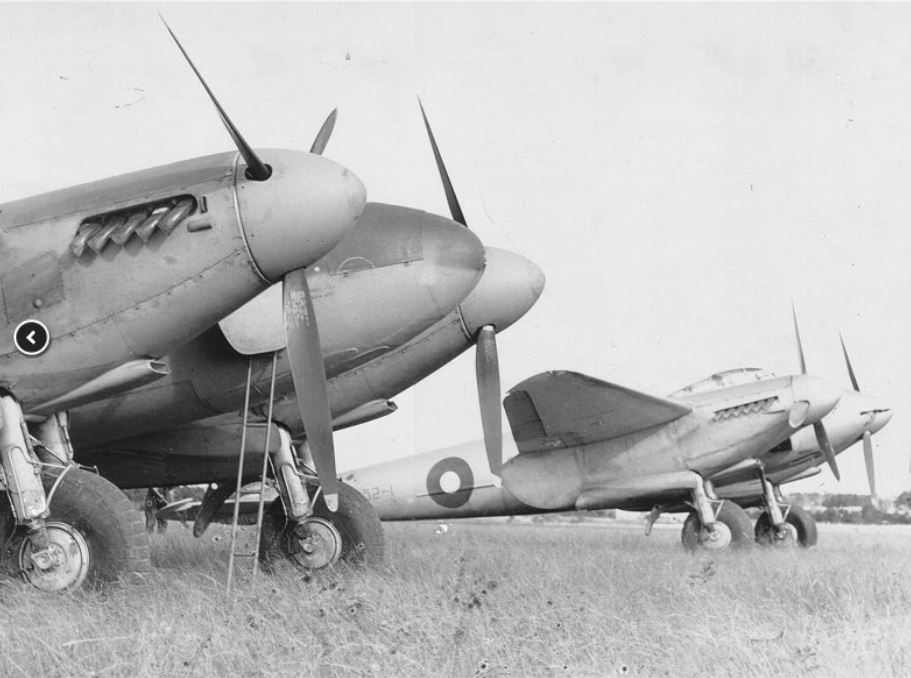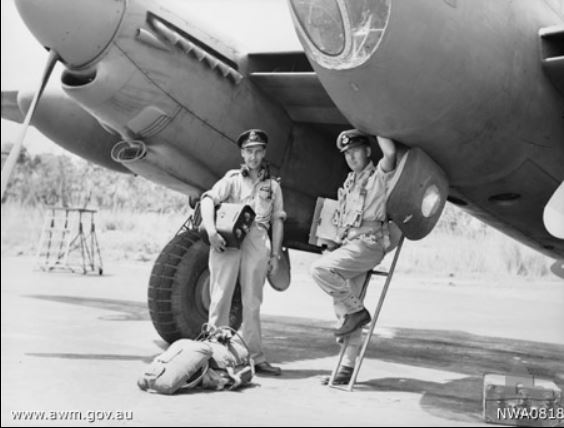Difference between revisions of "No. 87 Squadron RAAF"
From Our Contribution
| Line 1: | Line 1: | ||
{{Infobox | {{Infobox | ||
| − | | name = No. 87 Squadron RAAF | + | | name = No. 87 (Photo Reconnaissance) Squadron RAAF |
| title = | | title = | ||
| above = | | above = | ||
| subheader = | | subheader = | ||
| − | | image = [[File: | + | | image = [[File:87_PR_Squadron.jpg]] |
| − | | caption = | + | | caption = |
| − | | image2 = [[File: | + | | image2 = [[File:87_Squadron.jpg]] |
| − | | caption2 = No. 87 Squadron | + | | caption2 = The pilot and navigator of a No. 87 Squadron Mosquito returned from a mission in 1945 - AWM photo NWA0818 |
}} | }} | ||
| Line 14: | Line 14: | ||
==Brief History== | ==Brief History== | ||
| − | + | '''1 Photo Reconnaissance Unit RAAF''' was formed at Laverton Victoria on 8 June 1942. it operated six [[Brewster Buffalo]] aircraft. Initial navigation and photographic training was undertaken at Laverton before the unit began the move to Hughes airfield in the Northern territory on 12 Aug 1942. | |
| − | + | One Buffalo and a [[CAC Wirraway]] were destroyed in a Japanese bombing raid on 23 August, and another Buffalo and its pilot were lost in September. The unit received [[P-38 Lockheed Lightnings]] in October and the first operational flights began in November. It relocated to Coomalie airfield on 6 Dec 1942. An early focus for flights was Timor and Dutch New Guinea. Two Japanese raids on Coomalie during August caused only minimal damage. On 26 May 1944 the unit received its first Mosquito aircraft and the squadron flew missions over Java, Balikpapan, Biak, the Halmahera islands and the Philippines. The unit was re-designated '''No. 87 Squadron RAAF'''. As more aircraft were received, the number of missions increased. overflying islands in the Eastern Dutch East Indies. | |
| + | |||
| + | At the end of the war, No. 87 Squadron continued to conduct flights over Japanese held territory in order to monitor Japanese Army units until they could be disarmed. The squadron moved to Parkes, New South Wales, in October 1945 where it was disbanded on 24 July 1946. | ||
==Battle Honours== | ==Battle Honours== | ||
| Line 29: | Line 31: | ||
==Individual Honours== | ==Individual Honours== | ||
| − | * 1 x Member of the Order of the British Empire | + | * 1 x Member of the Order of the British Empire |
| − | * 4 x Distinguished Flying Cross | + | * 4 x Distinguished Flying Cross |
| − | * 7 x Mentioned in | + | * 7 x Mentioned in Despatches |
| + | |||
| + | ===Ground Crew=== | ||
| + | * [[Kevin David Anderson]] 18 Jan 1945 - 7 Feb 1946 | ||
| + | * [[Cyril Charles Cross]] 16 Oct - 18 Dec 1945 | ||
| − | |||
| − | |||
==Notes== | ==Notes== | ||
| − | + | Content comes from RAAF Historical Section (1995). ''Units of the Royal Australian Air Force – Volume 3: Bomber Units''. Canberra: Australian Government Publishing Service. | |
<references /> | <references /> | ||
Latest revision as of 13:02, 21 January 2021
 | |
 The pilot and navigator of a No. 87 Squadron Mosquito returned from a mission in 1945 - AWM photo NWA0818 | |
Contents
Brief History
1 Photo Reconnaissance Unit RAAF was formed at Laverton Victoria on 8 June 1942. it operated six Brewster Buffalo aircraft. Initial navigation and photographic training was undertaken at Laverton before the unit began the move to Hughes airfield in the Northern territory on 12 Aug 1942.
One Buffalo and a CAC Wirraway were destroyed in a Japanese bombing raid on 23 August, and another Buffalo and its pilot were lost in September. The unit received P-38 Lockheed Lightnings in October and the first operational flights began in November. It relocated to Coomalie airfield on 6 Dec 1942. An early focus for flights was Timor and Dutch New Guinea. Two Japanese raids on Coomalie during August caused only minimal damage. On 26 May 1944 the unit received its first Mosquito aircraft and the squadron flew missions over Java, Balikpapan, Biak, the Halmahera islands and the Philippines. The unit was re-designated No. 87 Squadron RAAF. As more aircraft were received, the number of missions increased. overflying islands in the Eastern Dutch East Indies.
At the end of the war, No. 87 Squadron continued to conduct flights over Japanese held territory in order to monitor Japanese Army units until they could be disarmed. The squadron moved to Parkes, New South Wales, in October 1945 where it was disbanded on 24 July 1946.
Battle Honours
- Darwin 1942–1944
- Pacific 1942–1945
- Dutch New Guinea 1945
- Borneo 1945
- Morotai 1945
Individual Honours
- 1 x Member of the Order of the British Empire
- 4 x Distinguished Flying Cross
- 7 x Mentioned in Despatches
Ground Crew
- Kevin David Anderson 18 Jan 1945 - 7 Feb 1946
- Cyril Charles Cross 16 Oct - 18 Dec 1945
Notes
Content comes from RAAF Historical Section (1995). Units of the Royal Australian Air Force – Volume 3: Bomber Units. Canberra: Australian Government Publishing Service.